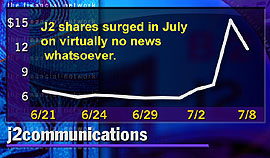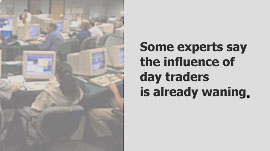|
Markets eye day traders
|
 |
September 1, 1999: 5:03 p.m. ET
Influential? Maybe, but market experts doubt day traders' long-term impact
By staff writer Tom Johnson
|
NEW YORK (CNNfn) - Try as he might, J2 Communications President and Chief Executive Jim Jimmiro couldn't break away from the Yahoo! chat room devoted to his company's stock earlier this summer.
In what ultimately became a textbook example of the trading habits of a small group of quick-in, quick-out investors known as day traders, J2 Communications' stock more than doubled in value one July day on volume more than 40 times higher than its typical trading day -- on virtually no news whatsoever.
Even Jimmiro, whose company's claim to fame is that it holds and licenses the National Lampoon trademark, had to chuckle as he struggled to explain his stock's dramatic one-day surge.

"It's just fascinating," Jimmiro marveled as he scrolled through the 130 or so messages that accumulated on his company's message board that day. "There's a big debate going on right now between the day traders and non-day traders."
That same debate is carried out daily these days on a handful of stocks that catch the eyes of day traders -- a small, elusive group that trades on momentum and leaves few footprints behind at the end of the day.
While long-term traders and market makers tend to scoff at their importance, there is little doubt the day trading community has had at least some impact on the daily operation of U.S. financial markets, most often revealed in the exaggerated short-term volatility of Internet stocks.

But whether that impact grows into something more significant and profoundly changes how markets conduct themselves, much the way derivatives or hedge funds once did, remains an open question.
In fact, many market experts say the influence of so-called "amateur day traders," or investors who quit their jobs and decide to invest their savings online full-time, already is waning.
"The amateurs are doomed to failure in my opinion," said Bob Haugen, chairman of Haugen Custom Financial Systems, a software company that develops investment models for portfolio managers, and author of "Beast on Wall Street, How Stock Volatility Devours our Wealth."
"Those guys will predominately lose money," he said. "They tend to do pretty well riding bull markets, but in the long-run, they really have no insight into determining which ways markets go."
The 800-pound gorilla
Day traders no doubt would argue with Haugen's last point. By some estimates, full-time day traders account for 15 percent of the Nasdaq's daily trading volume, giving them more than enough clout to move stocks, previously an ability exercised only by large institutional traders.
"It used to be that an institution was the 800-pound gorilla," said Buzzy Geduld, president of Herzog Heine Geduld, one of the oldest and largest Nasdaq trading firms. "Now, the individual is the 800-pound gorilla.
"You look at some of these new institutions, and the underwriters are befuddled by the reaction to some of these shares. But you have firms like ours with hundreds of thousands of orders and the largest one might be 300 shares."
But while day traders have proved effective movers of more volatile Internet shares, their influence becomes less apparent as companies get larger and their stocks harder to move. And with rumors swirling that a majority of day traders likely lose more money than they make, many market observers predict the practice will dissipate quickly at the first sniff of a bear market.
"There's this instant gratification to day trading and while we're in this wild bull market, up until a few months ago, all you had to do was buy an Internet stock and it would go up," Geduld said. "That is instantly gratifying, it's addictive and it's fun.
"But if we get just a touch of a bear market, I think day trading as we know it will disappear to a degree."
But the most profound impact day traders have had on the market, experts agree, is their exploitation of the Internet as a key investment tool.
From SOES bandits to day traders
Many date the advent of day trading back to the 1987 market crash, when individual investors complained the markets' age-old system of funneling all trades through market makers failed them when brokers simply stopped answering their phones.
As a result, regulators established the Small Order Execution System, an electronic network that essentially required brokers to accept trades sent their way. That led to the creation of the so-called "SOES Bandits," named for crafty online traders who would force a broker unaware of a share's moving price to sell to them at below market prices.

Professional day traders essentially operate the same way today, looking to capitalize on very small price movements of individual stocks. As one trader put it, "now the genie's out of the bottle and it's not going back in."
But that's where the similarities between day traders and speculative investors end, said Yale Hirsch, a Wall Street historian and author of the 1999 Stock Traders Almanac. Whereas speculative investors will trade on substance and trend lines, day traders tend to simply trade based on what's hot.
"Day trading is more of a mechanical thing that doesn't require any mechanical brawn, brain or discipline," he said.
That is why Internet shares have become so popular, he said. Internet companies are generally young and subject to wild trading swings based on speculation.
"We've always had periods when something came in vogue," Hirsch said. "This is different because of the Internet. It keeps on going and the riches just keep astounding everybody. All the traders that come up today naturally gravitate toward Internet stocks."
Day traders have indirectly impacted markets in other ways. Since investors making trades through electronic trading networks, as day traders do, don't have to go through market makers, those firms that clear trades have had to lower their execution provisions to keep their traffic flow -- and commissions -- up.
"I think the way people buy and sell securities has changed forever," Geduld said. "Commissions will never be the same again. This will cause an unbundling of fees and services."
But even in that sense, most market makers note the balance between lowered liquidity provisions and the number of people using online options is starting to level out.
Ultimately, day traders may be best know for the sweeping new rules they bring from regulators wary of Americans losing too much of their retirement money.
But most experts see that too as a losing proposition. It's tough to regulate people's ability to buy and sell stocks as they please within the market's legal trading bounds, they note. What will ultimately stop them, they say, is if the current speculation that most day traders lose money ultimately proves to be true. 
|
|
|
|
|
 |

|

